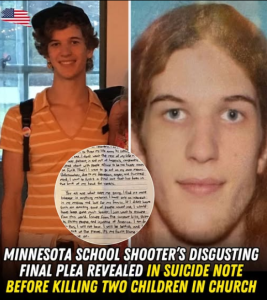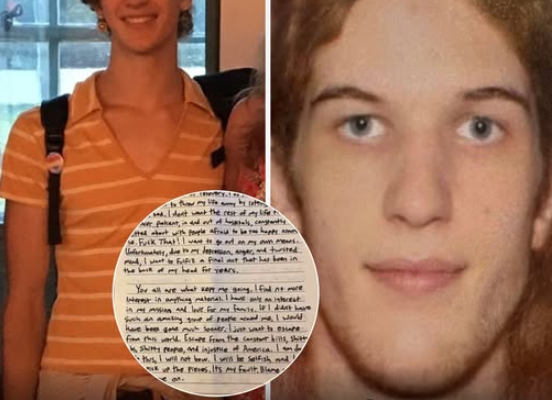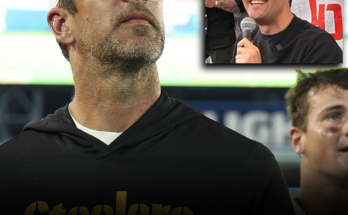A Prayer Interrupted: The Tragedy at Annunciation Catholic School
It was a quiet Wednesday morning at Annunciation Catholic School in Minneapolis. The children had gathered for Mass, their voices rising in hymns, their hands folded in prayer. Parents sat in pews, teachers guided restless students, and the sanctuary glowed with stained glass light. It was a moment of peace—until it wasn’t.
At 10:42 a.m., gunfire shattered the silence.
Robin Westman, 23, stood outside the church, armed with multiple firearms. He fired through the windows, deliberately targeting children. In minutes, two young lives were lost, and 17 others were injured. The horror ended only when Westman turned the gun on himself, dying in the rear of the church he once attended as a student.
The city of Minneapolis was left reeling. The nation mourned. And then came the note.
The Suicide Note
Hours before the attack, Westman penned a suicide note that would become the centerpiece of a domestic terror investigation. It was not a manifesto in the traditional sense—there were no grand political declarations, no coherent ideology. Instead, it was a fragmented cry from a deeply troubled soul.
“I’m sorry,” the note began. “To my mother, to my friends, to anyone who ever tried to help me. I couldn’t hold it together anymore.”
Westman described years of depression, isolation, and confusion. He wrote about feeling invisible, misunderstood, and consumed by pain. He asked his loved ones to “pray for the victims and their families,” acknowledging the horror he was about to unleash.
The note referenced other mass shooters—Natalie Rupnow, Anders Breivik—as if trying to place himself within a lineage of violence. It was chilling not because it was coherent, but because it wasn’t. It was a mosaic of suffering, rage, and misplaced identity.
A Troubled Past
Investigators quickly uncovered layers of complexity in Westman’s life. He had legally changed his name in 2020 with help from his mother, who had previously worked at the school. He had posted cryptic videos online, including one written in Cyrillic characters and another displaying an arsenal of weapons marked with political slogans and obscure references.
One magazine of ammunition bore the word “Skibidi,” a nod to a short-lived extremist message board. His rifle was scrawled with the name “Rupnow,” and another with “Breivik.” These weren’t just names—they were symbols of destruction, etched into tools of death.
Authorities believe Westman was active in hateful online communities, though his exact motivations remain murky. FBI Director Kash Patel described the attack as “anti-Catholic,” but experts caution against oversimplifying the shooter’s mindset. “It may not fit neatly in a box,” said Rachel Carroll-Rivas of the Southern Poverty Law Center. “Early indications show a young person expressing a mix of ideologies, politics, and inspirations”.
The Community Responds
In the aftermath, Minneapolis Mayor Jacob Frey urged the public not to politicize the tragedy. Some had seized on Westman’s gender identity—he was transgender—as a point of attack. Frey condemned such rhetoric, emphasizing that the focus must remain on the victims and their families.
The school held vigils, the church reopened its doors, and grief counselors were dispatched to help children process the trauma. But healing would be slow. The sanctuary, once a place of peace, had become a symbol of loss.
The Children
Their names were not immediately released, but the two children killed were remembered as bright, kind, and full of promise. One loved to draw, the other dreamed of being a veterinarian. Their desks sat empty the next day, adorned with flowers and handwritten notes from classmates.
Parents struggled to explain the unexplainable. Teachers wept in hallways. And across the country, another community joined the growing list of places forever changed by gun violence.
The Questions Left Behind
Why did Westman do it? Could it have been prevented? What signs were missed?
These questions echoed in newsrooms, living rooms, and legislative chambers. But answers remained elusive. Mental health professionals pointed to untreated trauma, social isolation, and the toxic influence of online extremism. Lawmakers debated gun control, school security, and the role of digital platforms in radicalization.
But beneath the policy debates was a deeper reckoning—a confrontation with the fragility of safety, the unpredictability of pain, and the haunting reality that even sacred spaces are not immune to violence.
A Nation Reflects
The tragedy in Minneapolis was not the first, and it won’t be the last. But each act of violence leaves a unique scar. It forces us to look inward, to ask hard questions about how we care for the vulnerable, how we respond to warning signs, and how we honor the lives lost.
Westman’s suicide note was a window into a tormented mind, but it was also a mirror held up to society. It asked us to see the cracks, the failures, the blind spots. It challenged us to do better—not just in preventing violence, but in understanding the pain that precedes it.
Conclusion: A Prayer for Peace
As the sun set over Minneapolis that evening, candles flickered outside Annunciation Catholic School. Parents held their children close. Strangers embraced. And somewhere in the silence, a prayer rose—not just for the victims, but for a world where such prayers are no longer necessary.
Robin Westman’s final words were an apology. But apologies cannot undo bullets. They cannot resurrect lives. They cannot erase trauma.
What they can do—if we let them—is remind us of the urgency of compassion, the necessity of vigilance, and the power of community to heal.


